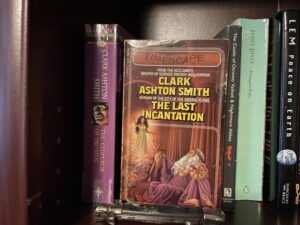
I picked up a copy of Clark Ashton Smith’s The Last Incantation. I figured I’d probably read some of the stories before in collections or anthologies before, and such proved the case. But there were some I had the pleasure of reading for the first time, and re-reading CAS is never a chore. It was a treat to revisit some old favorites.
A few comments on the contents:
The Double Shadow. The first of three of CAS’ Poseidonis stories. Atmospheric reiteration of a warning against hubris. Right off the bat CAS displays his mastery of growing horror.
The Last Incantation. The collection’s titular tale. Short, filled with gorgeous detail. In a sense this a parable illustrating Heraclitus’ axiom that you can never set foot in the same river twice. None of us remain the same person we once were.
The Death of Malygris. Beware a powerful sorcerer. Even if he does seem to have died. Or even if he has.
Seedling of Mars. CAS’ glorious prose creates a beguiling, immersive atmosphere in his fantasies, such as the Poseidonis stories preceding. But it can feel unnatural in what is purportedly a more-or-less straight forward science fiction story. For me, a bit of a clunker.
The Ice-Demon. I believe CAS’s Hyperborea stories are meant to chronologically precede his Poseidonis tales. This is a good one, a sort of Fire and Ice fantasy/action/horror story.
Ubbo-Sathla. Tangentially a Hyperborea story. This is more of a weird tale than a fantasy, a regression through the mists of time to a sort of Lovecraftian primordial dawn.
The Plutionian Drug. A rather simple science fiction story. CAS’s prose is less florid and more suited to the material. There isn’t much there, but it is well done for what it is. CAS writes drug-distorted perceptions vividly. One wonders…
The Colossus of Ylourgne. Always glad to get back to CAS’s Averoigne. In my personal literary universe, Averoigne and Joiry inhabit the same world and time. In some untold story, C.L. Moore’s Jirel crossed paths with Gaspard du Nord. Famously the inspiration of the D&D module Castle of Amber, Colossus is — while horrific — more of an adventure story than we normally get from CAS. A favorite.
The Holiness of Azedarac. An Averoigne time travel story, and — in rather a departure for CAS — a romance.
The End of the Story. An eighteenth century Averoigne vampire story.
The Vaults of Yoh-Vombis. Back to Mars, but unlike the unfortunate Seedling story, this is the Mars of Leigh Brackett and C.L. Moore — ancient, dry, and inhabited by Martians. CAS sets an Alien-like horror story in the ruins of a lost Martian city. Pretty good.
The Devotee of Evil. The final three stories are essentially weird tales, set at least in part in CAS’ contemporary California Bay Area. This one is a story of dark psychology and supernatural horror.
The Root of Ampoi. Perhaps the most traditional of CAS’ weird tales: an old-school adventure yarn featuring a shipwrecked British mariner and a lost civilization, as recounted to a California doctor.
Genius Loci. A slow burn of a descent into supernaturally induced madness. Old Man Willow and Tom Bombadill as portrayed in an evil fun house mirror.
So, as if anyone needs me to say it, Clark Ashton Smith is worth your time. This collection is a good one.
You know what else might be worth your time? Something of mine, though I’m not fool enough to claim I’m in the same league as CAS. Get yourself a copy of Blood and Jade, the first book in the Semi-Autos and Sorcery series. And please, leave reviews.
